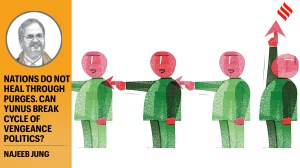To one who outmeasures space, outlasts time
The new millennium’s fifth year is behind us, and the sixth has arrived — although late by a billion nanoseconds. It’s time t...

The new millennium’s fifth year is behind us, and the sixth has arrived — although late by a billion nanoseconds. It’s time to muse, well, on time itself. We say that 2005 has joined the Past and 2006, which was in the womb of the Future until yesterday, has become the Present. We associate the past with the old and the present with the new. However, a little reflection is all it takes to realise how fluid these terms are. Where doth the past end and where beginneth the present? And where is the future if not already entering the portal of the present, sooner or later to submit itself to the past’s inescapable embrace? Time truly is a continuum, splendid in its aloofness and unyielding to any division. It is anaadi (beginningless) and anant (endless). It’s man, himself a creation of Time, who has created historical time with notions of the ‘‘past’’, ‘‘present’’ and ‘‘future’’.
The evanescence of all things new can be a bewildering thought. In our own lifetime, we have seen a millennium, a century, and many new years become old. As for new months, new weeks and new days, we don’t even notice them as they fade away. Moving from historians’ time to scientists’ time, the notion of old and new loses all meaning. Scientists, and increasingly computer and laser technologists, are working with split units of what for a layman is the smallest unit of time — namely, nanosecond (one billionth or 10-9 second), femtosecond (10-15 second) and attosecond (10-18 second). Thus, even before you utter ‘‘attosecond’’, trillions of them will have become history. Yet, it is atto-scale technologies that promise to soon create history by offering miniature machines (called MEMS or micro-electronic mechanical systems) with a revolutionary range of applications.
It gets more mystifying when you think of the smallest unit of time. Called Planck’s time (about 10-44 second), it’s the time taken to cover the smallest unit of distance (Planck’s length, about 10-34 m) at the fastest speed (light’s, about 3×108 m/sec). Time shorter than this makes no sense since, thereafter, uncertainties of quantum physics replace physics. It’s almost like time coming to a standstill. If this peek into the divided units of a second resembles metaphysics, contemplate a little on the multiple units of a millennium. Here man’s lifespan of 100 years looks like a mere nanosecond in Cosmic Time. In the Hindu tradition, with its cyclical movement of the Kali Yug, Dwapar Yug, Treta Yug and Satya Yug, a day in the life of Brahma, the creator of the universe, lasts 4,300,000,000 years. And Brahma lives for 311,040,000,000,000 human years, before a new Brahma begins a new cycle of time. But isn’t it mythology? Surely. But it does show that in no age has man abandoned his quest to understand Time and the Ultimate Reality. Huston Smith, a former MIT professor vividly describes the Hindu time-scale in his best-selling book Religions of Man: ‘‘The Himalayas, it is said, are made of solid granite. Once every thousand years a bird flies over them with a silk scarf in its beak, brushing their peaks with its scarf. When by this process the Himalayas have been worn away, one day of the cosmic cycle will have elapsed.’’
All of us, in our thoughtful moments, have wondered how tiny we are in this universe that stretches to infinity and how short-lived we are in a timeline that stretches to eternity. It’s so humbling a thought as to make some minds conclude that life is without any meaning and without any purpose. But the same thought can produce a cathartic spiritual experience revealing to us that we are, after all, not dispensable in the architecture of the universe, nor irrelevant to its little-known but undeniable design. Could it be that a part of us does not really die after our death? And aren’t we linked to an unbroken chain of life before our birth? To think so is to affirm that, for man, life is not merely a continuum but also evolutionary with a purpose. And history is the rocess through which mankind, if awakened, can realise that Great Purpose.
All religions have tried to create this awakening of the divine in man. They urge us to develop a worshipful attitude towards the Timeless (Akaal), which regulates all life in Time (Kaal). It is only our ignorance and arrogance that make us behave as if there is no tomorrow, as if there is no Higher Power surveying what we think and what we do in our transient physical existence. Of all kinds of arrogance, the one fed by political power creates the highest intoxication and produces the greatest harm. World history is full of tales of power-drunk kings, badshahs and fuhrers who thought that their empires would never crumble and that Time would never make their takhts bite dust. I am often mesmerised by the concept of ‘‘Akaal Takht’’ in Amritsar’s Golden Temple. It refers to the takht or the royal throne that is everlasting. Now, whose power and padshahi is everlasting in this universe? Of God alone.
In his poem ‘‘Who’’, Maharshi Aurobindo describes the Timeless One:
In the sweep of the worlds, in the surge of the ages, Ineffable, mighty, majestic and pure, Beyond the last pinnacle reached by the thinker He is throned in His seats that forever endure.
New Year’s Day is hence a time for bringing the lost sense of awe back into our humdrum lives; for letting our imagination wander from micro to mega reaches of space and time and realise our connectedness to both; and for offering a grateful prayer, in Aurobindo’s words, to ‘‘the One, who outmeasures Space and outlasts Time’’.
Wish you a happy and thoughtful 2006.
Write to sudheenkulkarniexpressindia.com






- 01
- 02
- 03
- 04
- 05

























